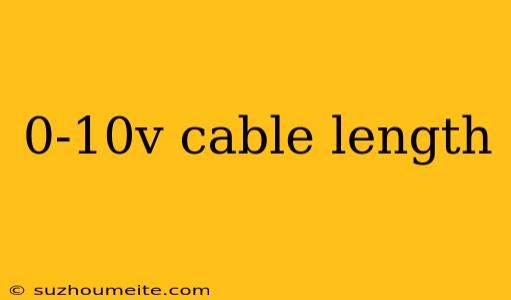0-10V Cable Length: Understanding the Impact on Signal Integrity
Introduction
0-10V is a common analog signal range used in various industrial control systems, lighting control systems, and building automation systems. The 0-10V signal is often transmitted over copper cables to connect sensors, actuators, and controllers. However, the cable length can significantly impact the signal integrity, accuracy, and reliability of the system. In this article, we will explore the effects of cable length on 0-10V signal transmission and provide guidelines for selecting the right cable length.
Signal Attenuation
As the signal travels through the cable, it is subject to attenuation, which is the reduction in signal amplitude over distance. The longer the cable, the more the signal is attenuated. This can lead to errors in measurement, reduced accuracy, and even system malfunction.
Cable Resistance
Cable resistance is another critical factor affecting signal transmission. As the cable length increases, the resistance also increases, causing the signal to degrade further. This can result in signal distortion, noise, and errors.
Cable Capacitance
Cable capacitance is the ability of the cable to store electrical charge. As the cable length increases, the capacitance also increases, causing the signal to become sluggish and distorted.
Impact of Cable Length on 0-10V Signal
The combination of signal attenuation, cable resistance, and cable capacitance can have a significant impact on the 0-10V signal. A longer cable length can result in:
- Signal Loss: The signal amplitude decreases, leading to errors in measurement and reduced accuracy.
- Signal Distortion: The signal waveform becomes distorted, leading to incorrect readings and system malfunction.
- Noise: Electromagnetic interference (EMI) and radio-frequency interference (RFI) can infiltrate the signal, causing errors and noise.
Guidelines for Selecting Cable Length
To ensure reliable and accurate signal transmission, follow these guidelines for selecting cable length:
- Short Cable Lengths: Use shorter cable lengths (less than 100 feet) for critical applications where signal accuracy and reliability are paramount.
- Medium Cable Lengths: Use medium cable lengths (100-300 feet) for general-purpose applications where signal accuracy is important but not critical.
- Long Cable Lengths: Use long cable lengths (over 300 feet) only when necessary, and ensure that the cable is properly shielded and terminated to minimize signal degradation.
Conclusion
In conclusion, cable length has a significant impact on 0-10V signal transmission. Understanding the effects of signal attenuation, cable resistance, and cable capacitance is crucial for selecting the right cable length for your application. By following the guidelines outlined in this article, you can ensure reliable and accurate signal transmission in your industrial control systems, lighting control systems, and building automation systems.
